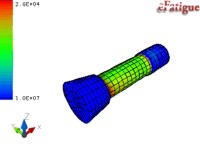
Finite Element Model
 In addition to computing fatigue lives, these fatigue analyzers are used to transform finite element model stress contours into
fatigue life or safety factor contours. Just upload your FEA results file and let eFatigue do the analysis.
In addition to computing fatigue lives, these fatigue analyzers are used to transform finite element model stress contours into
fatigue life or safety factor contours. Just upload your FEA results file and let eFatigue do the analysis.
There are two primary methods for estimating the fatigue resistance of components and structures from Finite Element Model results. Stress-Life analysis assumes that the stresses always remain elastic even at the stress concentrators. Most of the life is consumed nucleating small microcracks. This is typical for long life situations (millions of cycles) where the fatigue resistance is controlled by nominal stresses and material strength. Strain-Life is used for situations where plastic deformation occurs around the stress concentrations. An example would be in a structure that has one major load cycle every day. Both stress-life and strain-life provide an estimate of how long it will take to form a crack about 1mm long. We suggest that you first review the constant amplitude section if you are unfamiliar with the basic methods and terminology.
eFatigue provides analytical tools for processing FEA data for both of the methods. Fatigue analysis from a finite element model is essentially the same as constant or variable amplitude fatigue analysis with two major differences. First, multiaxial stresses must be considered in the fatigue assessment. In ductile materials, multiaxial stresses considerations are particularly important because shear stresses, not principle stresses, are responsible for the nucleation and initial growth of fatigue cracks. The simple uniaxial approach contained in many other fatigue post processors is simply inadequate. Second, eFatigue includes stress gradient effects for an accurate fatigue life estimate.
The ANSYS *.rst file, ABAQUS *.fil, Pro Mechanica ASCII, and Solidworks ASCII file formats are currently supported.
Results from the fatigue analysis are summarized in contour plots and a series of bar charts. You may download a results text file for viewing in an editor. The format is compatable with the open source graphical viewer Paraview. To use Paraview just change the file extension from *.txt to *.vtk. eFatigue also returns an *.rst or *.fil file with the fatigue results for more detailed display with your own plotting software.
Finders are provided to obtain the necessary input information for material properties.
Fatigue Analyzers
Sign in or sign up to use these analyzers